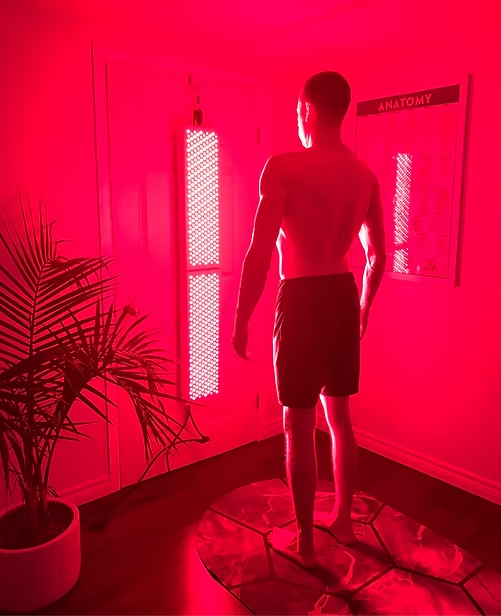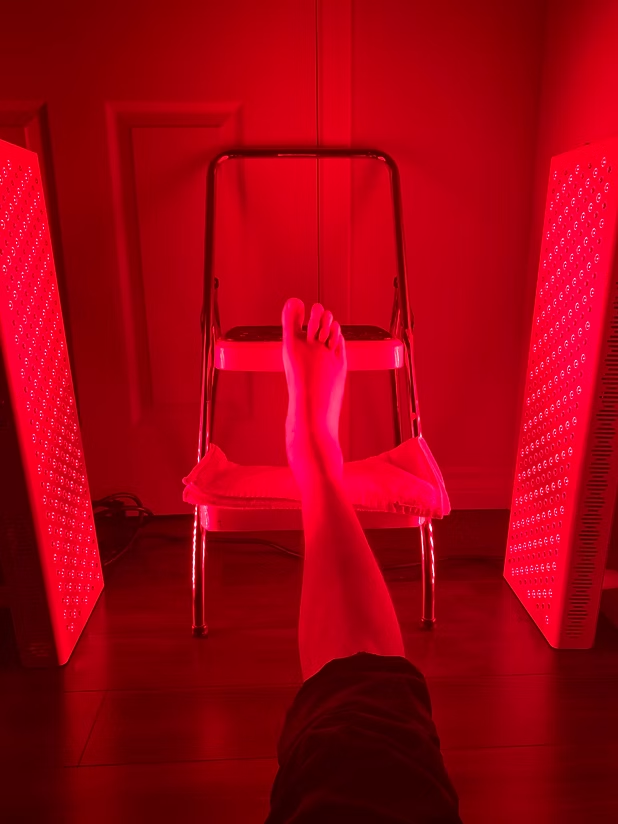
Red Light Therapy & Photobiomodulation
Photobiomodulation can be thought of as the human version of the way that plants photosynthesize & has been the subject to over 4000 studies. How it works is, our cells absorb this light energy which initiates a series of physiological reactions leading to restoration of optimal cell structure & function. Low level laser therapy (LLLT), also known as cold laser therapy is a type of photobiobodulation that uses light-emitting diodes (LED) to produce specific wave lengths of light called red-light & near-infrared light.
When these wave lengths of light are applied to the skin & underlying cells, they are absorbed by the mitochondria (the powerhouse of the cell), within each mitochondria a reaction takes place. A chain of proton pumps generates a higher concentration of protons outside of the mitochondria than inside. This gradient allows our cells to use oxygen more efficiently & produce energy rich molecules like ATP (Adenosine Triphosphate) which is your bodies primary form of usable energy & is a key factor in cellular performance. By stimulating the production of ATP, more energy is delivered to the cells, helping them undergo self repair. A mitochondrial enzyme called cytochrome oxidase-c can also accept energy in the form of light to enhance cellular function.
Red Light light Vs. Near-Infrared light
Red light uses a wavelength of 660nm & is absorbed by our skin & cells at the surface, this enhances skin healing & overall skin health. This is the reason that it has become so popular with medi-spas. Near-Infrared light uses a wavelength of 850nm & is invisible to the human eye, this penetrates deeper into the tissue to enhance recovery & decrease inflammation. This is why near-infarared light has been adopted by so many pro athletes, sports teams & trainers.

Red light & Near-Infrared light Therapy may:
Increase Cellular Function & ATP Production
By stimulating the production of ATP more energy is delivered to the cells, helping them undergo cell repair.
Increase Elasticity of Collagen Fibers
Rejuvenates the skin by making energy production more efficient, enhancing cellular respiration & less oxidative stress.
Reduce Inflammation
By encouraging the natural inflammation process it helps reduce pain & helps injuries recover more quickly.
Increase Lymph drainage
By relaxation the lymphatic vessels it has shown to increase the permeability of lymphatic endothelium that allows molecules to be transported by lymphatic vessels.
Increase Blood flow
By recieving more oxygen & nutrients to the tissue, a significant increase in blood flow is observed after treatment.
Help Regulate Circadian Rhythm & Improves Sleep
It has been shown that the more sunlight or red-light that you get during the day, the easier it is to fall asleep at night without needing it to be very dark. Dr. Sachin Panda is one of the leading researchers in circadian rhythm & has a fantastic book called The Circadian Code with a ton of ways that you can optimize your circadian rhythm.
Aids in Recovery from Injuries & Improves Performance
By safely and effectively decreasing both inflammation and pain in injured student-athletes, red light therapy allowed a shorter return to participation in sports activities and training than is generally the case with musculoskeletal or soft tissue injuries.
Increase Testosterone in Men
Leydig cells in the testis of men respond well to these wave lengths by upregulating their cytochrome oxidase. This has been shown to have an increase in total & free testosterone. Leydig cells also play a crucial role in healthy sperm production.
How it Differs from Natural Sunlight
Wave lengths of light from natural sunlight exposure also upregulates mitochondria activity & energy but sometimes we don't have the ability to go out in the sun, especially if you work all day, it's cloudy out or its winter where its dark before 6pm. When this is the case, you're not getting an optimal amount of red light. Whereas with red light therapy, you can get a huge dose of red light in only 10-20 minutes, which is around the equivalent to 4-6 hours in the sun but without exposing yourself to harmful UV-A & UV-B radiation. Getting natural sunlight is still important as UV radiation has been shown to have a beneficial hermetic effect but 4-6 hours of sunlight has been shown to be problematic in many ways.
My Experience
I have been certified as a professional Laser therapist since 2020 & have seen significant improvements with consistent treatments. The device I use can is able to be stacked on top of each other to get full body coverage or able to be placed on either side of a problem area for a more specific treatment.
Pair this with a good morning breathwork/mediation practice, low-intensity steady state cardio like walking, grounding, rebounding, yoga, qi-gong, tai-chi, followed by a heat & cold thermogenesis practise like sauna, cold thermogenesis practise like sauna, cold bath or warm-cold shower & recovery game will be high level.
Click book now & scroll down to Red Light/LLLT to book in for a session or buy a package. You can also add Red light therapy as an upgrade to your massage therapy treatment, as it is covered under Registered Massage Therapist insurance.

